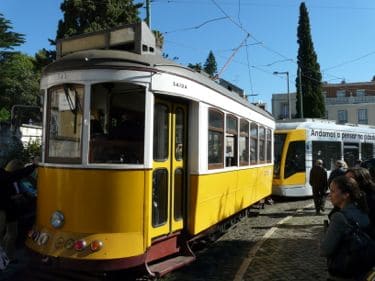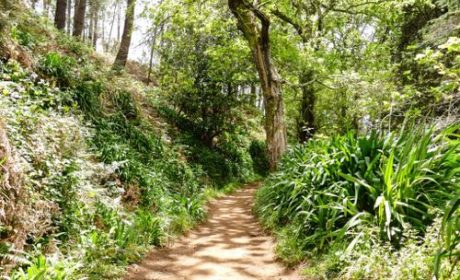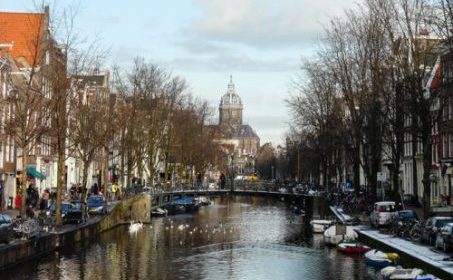As far as hot travel destinations, it looks like Portugal is going to have one heck of a year. All of the in-the-know lists are pointing to the European country as the next “it”destination – and it’s easy to see why.
Hopefully, the crowds won’t do more harm than good and small off-the-beaten-path destinations such as Lamego, Portugal will retain their authentic quality. Guest contributor, Debi Lander from ByLanderSea, is here to tell us all about her day exploring this charming town.
Portugal, a country in Southwestern Europe, borders Spain and the Atlantic Ocean. It may not sit atop your wish list, but I can assure you from my two-day stopover in Lisbon, I wish I had gone sooner and stayed longer.
Stop in Lisbon on the way to Lamego
The capital city’s charm unfolds within the tightly packed alleyways of the Alfama district, and along the River Tagus, stopping at the Monument to the Discoveries, dedicated to the early Portuguese explorers. It moves to soulful Fado, longing and sorrowful music accompanied by the Portuguese guitar, and tastes of fresh seafood.

Lisbon was razed in 1755 by a devastating earthquake, so the architecture runs predominantly 18th century. My favorite venue became the National Tile Museum housed in an old convent and full of intricate Portuguese azuelos, blue and white or tile art. The building incorporates an ornate golden chapel and a 174-foot tiled mural of the city, the best historical record prior to the natural disaster.
(Short video clip of the immense tile mural of Lisbon.)
While Lisbon served up endless options, for me, it is often the little towns and villages that result in deeper travel connections. These off-the-beaten-track adventures bring unexpected surprises and frequently evoke more powerful memories than the major cities.
Exploring Lamego, Portugal
Lamego, a small town in northern Portugal and the area known for its production of port wine, is one of those places. I visited Lamego on the final day of my Viking cruise along the Douro River, called Portugal’s River of Gold. Wine has been produced there for two thousand years and is the golden currency that sustains the area.

As background for the visit, Viking’s Program Director introduced us to the town’s history through a slideshow presentation. “The Romans came first,” she said, “as early as 500 BC, followed by the Visigoths.
Later, Lamego was captured by the Moors, reconquered by the Christians, and then returned once again into Muslim hands, until Ferdinand I, king of Castile and León, definitively took it in 1057. He was also the great-grandfather of D. Afonso Henriques, who became the first king of Portugal.”
I learned that one of the most important events to take place in Lamego was an assembly of nobles who, in 1143, officially declared Afonso Henriques Portugal’s first king.
Today, the remains of a few buildings begun by King Alfonso stand as evidence of those medieval times: a castle and 13th century keep on a hill overlooking the city, the Lamego Cathedral and the small church of Santa Maria de Almacave. The façade of the Almacave church displays an excellent example of Romanesque art.
Legend claims Bishop António Telles de Menezes poured a sack of gold coins into the mold when the great bell was being cast. He wanted to ensure that its sound would be the richest in the world. Whether fact or fiction, I just love the fable.
While Lamego’s cathedral was built in the Gothic style, renovations and additions took place between the 16th and 18th centuries. However, its exterior and the cloister make it worth a peek. Another advisable stop is the 18th century Episcopal palace currently home to the town’s museum, including some 16th-century Flemish tapestries and important works by the Portuguese master Vasco Fernandes (Grão Vasco).
Climbing St Stevens Hill

The most compelling reason to visit Lamego concerns Saint Stephen’s Hill, the other highpoint in the town. The hill originally housed a small chapel dedicated to the saint in 1361. Over time, the residents’ devotion to St. Stephen declined while a growing admiration of the Virgin started.
In the 16th-century, the bishop of Lamego commissioned the holy fathers in Rome for a statue of the Virgin Mary, one that would cure illness. (I find it odd that one could order such an icon, but I suppose if the clergy needed one, the Vatican produced.) The Bishop then arranged to build a new house of worship in place of the earlier chapel dedicated to St Stephen.

The number of worshippers of Our Lady of Remedies, as the venerated statue became known, continued to blossom. By1750, they broke ground for the construction of a regal shrine to honor her.
But, the entire project with twin towers and a spectacular staircase didn’t reach completion until 1905, 155 years later. The hillside still incorporates a forest, the Park of St. Stephen, lending a rather mystical feel.

Today, Lamego continues to draw pilgrims to the church of Nossa Senhora dos Remédios or Our Lady of Remedies. Every September 6th through 8th, thousands of supporters make their way to the landmark during a celebration called “Romaria de Portugal.”
On the days leading up to the religious festival, celebrations include a torchlight procession with a parade of allegorical floats and flowers. The climax arrives when a large wooden frame bearing the statue of Our Lady appears on a decorated cart pulled by coupled oxen. Special permission must be granted by the Vatican for the statue to be carried by animals.
Some of the ailing followers slowly climb the stairs to the chapel on their knees. This ascent is no small feat as the double zigzagging stairway to heaven includes 684-steps. When the faithful finally mount the summit, they enter the shrine and through tears and prayers ask the Virgin to be healed.
Visiting Our Lady of Remedies in Lamego
I visited Lamego on a day in December. My fellow cruise passengers and I only had time for a brief stop since fog had delayed the ship’s progress.
Some guests chose to investigate the old cathedral and spend the rest of the allotted time shopping, but others desired to tour the shrine on the top of the 2,000-foot hill. I rode the bus up to the sanctuary with the later group.

Soon, I found myself above the town and standing before the Baroque hilltop chapel centered between two towers. Looking up as I entered the nave, I was awed by the Wedgewood blue and white ceiling that looked like a setting for a formal banquet.
The walls were plastered with decorative swirls, scrolls and twisted columns coated in gold leaf. Saintly figures rested within the decorative niches while intricate religious azulejos (tiles) lined the walls and acted as wainscoting.
The recessed central altar attracted my eye, a shimmering sunburst of light behind the golden statue of the Virgin. Her diminutive size did not diminish the spiritual powers she is claimed to embody.
My small group dwelled, basking in the splendor while some lite votive candles and said prayers. Those desiring a ride down the hill returned to the bus, but I dallied, hoping to capture some photos without the interfering shadows of the others. My friend Carol also remained, shooting pictures as did Mark, another from the ship, who seemed captivated by the aura in the sanctuary.
I continued working my camera when I noticed a short, elderly nun coming in my direction. I hoped she wasn’t going to shake angry fingers at me and make me stop. Thankfully she was okay with my photography but motioned for me to follow her.
She did not speak a word of English, nor I Portuguese, but I understood her request. I dutifully followed calling to the other two to come along. We made our way back into the sacristy behind the main altar.
There, presiding from on high, yet behind a locked gate, stood a more modern, lustrous statue of another smiling Madonna. She was breastfeeding baby Jesus. I had noticed a few Mary images in Portugal who were pregnant, but this was my first contact with a breastfeeding one. She was larger, more human-looking than the Holy Virgin on the main altar.

Breastfeeding Madonna’s or Our Lady of Milk as I learned they are called, are not common. The saintly Virgin with bared breast is not how most envision the Queen of Heaven, so perhaps some apprehensive parishioners requested the figurine stay secluded in the back. I wanted to know more about her.
The nun had been insistent on my seeing her. Maybe, I thought to myself, “This is a more modern “Lady,” one who nourishes and grants miracles to the sick today”? Unfortunately, no one was around to verify nor can I find any official documentation from my extensive research.
But, I stood silently, rooted in place as I felt a divine presence emanating within the room. I believe a sacred place takes on a rarified air from the thousands who come there to pray.
I’ve certainly felt this state of devotion in other famous pilgrimage cathedrals like St Peter’s Basilica on a visit to Rome, Chartres, and Assisi. (Fatima is the most famous pilgrimage church in Portugal, but I haven’t visited.) However, I wasn’t expecting the personal interchange with the nun.
Her sweet smile and the piety with which she revealed the treasure were a gift. While my photos remind me of this experience, it’s the parting hug from the nun that deeply connected me with the shrine. She and the love within will stay with me forever.
Walking down St Stevens Hill

After this extraordinary encounter, I slowly made my way to the top of the imposing staircase. The vantage point overlooking the town and hills of the Douro Valley is truly dramatic, one of the must-see locations in the region.
Then, I descended the grand staircase and paused at each of the nine terraces. I noticed more of the intricate blue and white tile art, each level portraying a scene from the Virgin’s life. It’s a moving journey full of fountains, obelisks and other small statuary that provide many opportunities for devotion.
At the base lies the town’s central square, a public garden with more symbolic statuary surrounded by elegant 17th-century buildings and some modern shops. Since Portugal remains a predominately Roman Catholic society, it was no surprise that I discovered a life-sized nativity.
Within a few minutes, I reached the opposite end of town and the spacious plaza featuring the town’s museum and a statue of the bishop who built the shrine. I wished I could have lingered and discovered more.
However, it was time to board the bus and return to my cruise ship by a drive through the atmospheric landscape. During the past week, I had explored the historic center of Porto, including a fantastic bookshop that inspired JK Rowling.
I’d also trampled along the terraced hillsides of wineries, learned about the production of port or fortified wine, sampled the local vintages, toured the Mateus Palace (famously gracing the oddly shaped wine bottles popular in the 1960’s), and stopped in Castle Rodrigo, a UNESCO World Heritage site.

Douro River cruises offer a relaxing way to see the valley’s picturesque hills and towns. Cruises usually begin in Porto and travel to the border of Spain including exploring things to do in Salamanca, before returning. My Viking cruise included two days in Lisbon prior to boarding the ship thereby giving me the opportunity to sightsee the highlights of the country.
Looking for more Portugal travel adventures? Consider our suggestions of things to do in Braga, an off-the-beaten-path Portugal travel destination.



